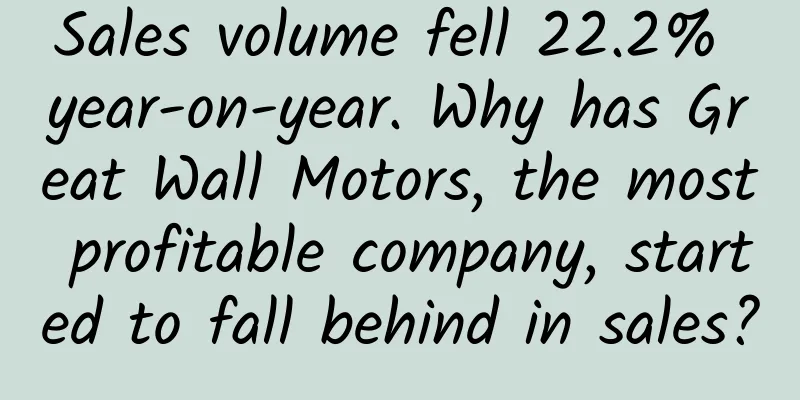Sales volume fell 22.2% year-on-year. Why has Great Wall Motors, the most profitable company, started to fall behind in sales?

|
For a prestigious automobile company, falling behind when it should have had a good start is definitely not good news. On February 4, Great Wall Motor released its January sales data, with sales reaching 80,933 units, a year-on-year decrease of 22.20%. As one of the leading companies in China's automobile industry, and known as the "Five Tigers of Independent Automobile" along with BYD, Changan Automobile, Chery, and Geely Automobile, Great Wall Motors achieved this result in the first month of the new year, which really gave everyone a sense of disappointment. On the other hand, the other four tigers: BYD's sales in January reached 300,500 units, still ranking first among automakers in terms of sales; Geely Auto sold 266,700 vehicles in January, up 24.9% year-on-year, setting a record for Geely's best monthly sales in history. Chery's overall sales in January reached 224,323 vehicles, achieving a year-on-year growth of 10.3%; Even though Changan Automobile's sales fell slightly in January, it still maintained its brand sales record of "starting with the 2s" with sales of 275,700 vehicles. In this comparison, Great Wall Motors clearly gives people a feeling of being "left behind". 2025 had a bad start, what happened to Great Wall Motors? From the overall environment, the entire automotive industry is actually facing certain pressures from the end of 2024 to the beginning of 2025. Factors such as the economic downturn and fluctuations in consumer confidence have led to a weakening of demand in the automobile consumer market. Coupled with the impact of the new year's policy of reducing subsidies for new energy vehicles, people have become more cautious in buying cars. Against this backdrop, the entire industry has been greatly affected. In January, the consumption momentum in the auto market was relatively weak. Data from the China Passenger Car Association showed that retail sales fell 28% in the first week and 16% in the second week. Although there was a year-on-year increase of 20% in the third week, there was a Spring Festival holiday in between, so the auto market data in January did not look very "beautiful". Of course, Great Wall Motors’ failure in January was not entirely related to the overall environment. Judging from its past performance, Great Wall Motors itself also had certain problems. Mr. Wei, the head of Great Wall Motors, once said that he is not afraid even if Great Wall Motors (sales) falls out of the top ten, because in order to develop healthily, it is better to do less and have a lower market share than to pursue meaningless sales. This sounds quite generous, but if you think about it carefully, you will find that this kind of "generosity" about sales volume is obviously a bit too much. Looking at the current automobile market, any brand needs to rely on sales volume to conquer the world. Generally speaking, the market often only looks at sales volume when ranking companies. Look at the mainstream car companies at home and abroad. For example, Toyota and Volkswagen are competing for dominance based on sales volume, and BYD, Geely, Changan, and Chery are competing for the first place based on sales volume. Great Wall Motor's "indifferent" attitude towards sales has also caused its monthly sales to fluctuate around 100,000 in the past two years. Compared with other Chinese automakers that have entered acceleration mode, Great Wall Motor has obviously fallen behind. According to the recently announced sales figures for January, the sales of Great Wall's five brands have all declined. Among them, the sales of the Haval brand in January were 48,557 units, a year-on-year decrease of 17.84%; the sales of the WEY brand in January were 5,007 units, a year-on-year increase of 49.42%; The sales volume of the Ora brand in January was 2,193 units, down 63.46% year-on-year; the sales volume of the Tank brand in January was 12,845 units, down 35.99% year-on-year; Great Wall Pickup sold 12,321 units in January, down 20.33% year-on-year, and the decline is further widening. Overall, among the five major brands under Great Wall Motors, except for the WEY brand whose sales increased year-on-year, the other four brands all saw declines of more than double digits. The decline in sales not only makes Great Wall Motor's data look unimpressive, but also has a huge impact on automakers' efforts to seize market share. Great Wall Motors has always focused on SUV models and pickup trucks, and the Haval brand is responsible for its sales. However, since the Haval H6 no longer continues to win the championship and there are more and more competitors in the market, its position in the SUV field is also precarious. Sales of the Ora brand in the sedan field have also been declining continuously, with its sales in January being only more than 2,000 vehicles, causing Great Wall Motors to almost lose its voice in the sedan market. The dominant position of the Tank brand in the past two years has gradually been diluted by BYD, Chery and Changan Automobile. At a time when hard-core off-road products are flourishing everywhere, models that can compete head-on with the Tank brand are no longer scarce, and it is difficult for Great Wall Motors to gain more market share in this field. Even though the WEY brand is in a state of growth, its sales in January were only more than 5,000 vehicles, which had limited effect on boosting overall sales. What's more, WEY has launched many models, but many of them have been discontinued. In recent years, it has discontinued many models such as Macchiato DHT, Macchiato DHT-PHEV, and Latte DHT. This practice of "discontinuing production within one year of launch and out of print within a few months of purchase" makes it difficult for consumers to have confidence in it. Therefore, its market position is relatively limited. In the extremely realistic automobile market, its major brands are unable to prove their strength in terms of sales. From a long-term perspective, it will naturally be difficult for Great Wall Motors to make a breakthrough in its influence in the market. Of course, Great Wall Motors is not without ambition. It once set a sales target of 1.9 million vehicles by 2024, but the actual completion rate was only 64.91%, with cumulative sales of only 1.233 million vehicles. It is common for car companies to fail to achieve their sales targets, but for large manufacturers like Great Wall Motors, there is a very close relationship between corporate goals and factory matching production capacity. Generally speaking, before setting goals for the next year, companies need to allocate production capacity to the factory in advance, which is also the key to ensuring the normal operation of the factory. If sales continue to decline, it means that there is likely to be excess productivity. When a company cannot support its factory with its products themselves, operational problems will naturally follow. Even though the goal is always difficult to achieve, Great Wall Motors still enjoys opposing the Flag. On the 30th anniversary of its establishment, it set itself a 2025 strategic goal of achieving annual global sales of 4 million vehicles. Although Great Wall Motors has not yet encountered such problems, it is not an unfounded worry if it cannot balance its sluggish sales with its ambitious goals. Great Wall Motors, which is not very successful in terms of sales, also has a confident side. Wei Jianjun once said publicly, "If Great Wall Motors is not profitable, then there will be no profitable companies." On January 14 this year, Great Wall Motor released its profit forecast, predicting that the company will achieve a net profit of 12.4 billion to 13 billion yuan in 2024, an increase of 5.378 billion to 5.978 billion yuan compared with the same period last year, with a year-on-year growth rate of 76.60% to 85.14%. In terms of profitability, Great Wall Motor is indeed confident and can be regarded as one of the most profitable automakers in the country. In addition, Great Wall Motors has also performed well in overseas markets. Its overseas sales in January reached 28,016 units, an increase of 6.23% over the same period last year. The international strategic layout has begun to show results. In the current situation of increasingly fierce competition, sales and profits are two aspects that car companies must balance well, and they can even be said to be two indispensable conditions for survival. For car companies, only with sales can they have market share and stabilize the user base, and only then can car companies and their upstream and downstream ecological chains survive. Great Wall Motors, which only has the advantage of profitability, is obviously not doing enough. |
>>: NAP: Artificial Intelligence and the Future of Work in 2024
Recommend
The Double Eleven War is about to start. What are the routines and methods of JD.com and Alibaba?
While waiting for the arrival of this year’s Doub...
New bionic leg allows amputees to walk easily, it is light, powerful and can generate its own electricity
In life, everyone may encounter some misfortunes ...
Adient to design 'active seats' for autonomous vehicles
Fully automated cars controlled by computer syste...
11 ways to improve programmers' work efficiency and keep you away from overtime
Are "hardworking" and "working ove...
How to quickly increase fans on Kuaishou? How to buy Kuaishou fans?
Professional Douyin and Kuaishou likes-boosting p...
How much does it cost to be an agent for a mobile app in Nagqu?
How much does it cost to be a mobile app agent in...
I've experienced the iPhone SE2 for a day, and I've talked about its pros and cons. I understand it after reading it.
On April 24, 2020, Apple started selling the seco...
Lao Duan talks about OTT: How does Internet TV make money?
2013 was the concept year of Internet TV in China...
People who don't like to open windows are more likely to have brain atrophy?! These 5 things we do every day are actually very harmful to our brains
There is a saying on the Internet: "People w...
5 practical typography tips to improve the high-end feel of UI interface
In the UI interface, typography design is equally...
Kuaishou operation guide for the clothing industry!
Physical clothing is not easy to make, I believe ...
New Brand Growth Trap
When traditional brands are already very strong, ...
Standing on the shoulders of Shannon and Boltzmann, looking at the art and philosophy of deep learning
Standing on the shoulders of Shannon and Boltzman...
Community operation: How to create a high-quality paid community?
This may be the most comprehensive explanation on...
What are the specific methods of selling products on Douyin?
From Haidilao to Daancha, Douyin has demonstrated...









